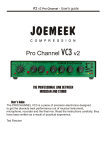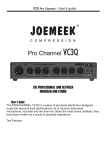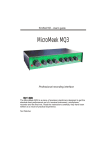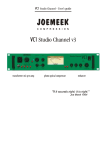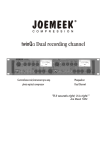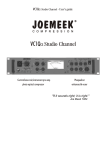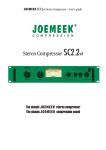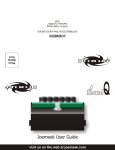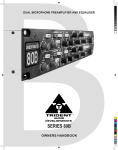Download VC6Q - Joemeek
Transcript
VC6Q British Channel - User's guide JOEMEEK C O M P R E S S I O N VC6Q British Channel mic pre amp photo optical compressor Meequalizer THE PROFESSIONAL LINK BETWEEN MUSICIAN AND STUDIO User's Guide The British Channel VC6Q is precision electronics in the style of Joe Meek, the first independent record producer in the 1960's bringing humanity and individuality back to sound recording at the millennium. It's there to get the absolute best performance out of musical instrument, microphone, recorder and the final mix. Read the instructions carefully; they have been written as a result of practical experience. Ted Fletcher VC6Q British Channel - User's guide 1 VC6Q British Channel - User's guide INSTRUCTION BOOK CONTENTS The JOEMEEK British Channel - What it is 3 What's in it - The Input Amplifier - The JOEMEEK Compressor - What is a compressor? - The Equaliser 4 4 5 6 Control Explanations 6 Connecting the VC6Q 8 Making the British Channel GO - Using the Input Amplifier - Using the Compressor - Using the Equaliser - Using the ins and outs 9 9 9 10 Common problems 11 Technical performance 12 Ted Fletcher This instruction book was written by Ted Fletcher; the designer of the original JOEMEEK compressor and the whole JOEMEEK range of professional audio equipment. Ted worked in the studio with Joe Meek, the legendary record producer, in the mid 1960s. 2 VC6Q British Channel - User's guide THE JOEMEEK British Channel THE JOEMEEK British Channel VC6Q WHAT IT IS AND WHY The British Channel is an input conditioner. A microphone or musical instrument preamplifier designed to bridge the gap between the performing musician and the recording studio. It's been designed especially to be easy to operate, yet will give the finest professional 'glitter' to the sound; without hours of tweaking. QUALITY AND BIG SOUNDS It's my theory (and was Joe's) that 'big' sounds can only be produced if the lower frequencies in an input amplifier are kept absolutely flat and under control. To achieve this, the MeekBox has an extended frequency range well below 20Hz. This ensures that there are no sudden phase shifts in the low end. The proof of the theory is that it sounds great! QUALITY AND OVERLOAD MARGINS In the mid 1970s I designed a range of mixers specifically for Independent Local radio stations and the BBC. One of the specification clauses insisted on was an extreme overload margin on the microphone amplifier. The reason was that although momentary overloads (transients) are not audible, they have an effect on the quality of the sound you hear. A high overload margin amplifier just sounds better. Nowadays, many of these notions have been forgotten and 'quality' electronics is getting rarer and rarer. But the JOEMEEK range of specialist electronics applies these professional rules and you can hear the difference! The function of a microphone preamplifier is not complex, and the microphone/input amplifiers on normal professional mixers do it quite well; BUT they cut costs and corners. The British Channel has a specialist approach, it uses a super quality transformerless input stage in combination with a low-noise input amplifier; the overall design produces an input stage with excellent low noise characteristics and high margin capability. Joe would have loved one of these! 3 VC6Q British Channel - User's guide An interesting fact is that the cost and quality of the parts in the British Channel input amplifier are on a par with those used in the very highest priced professional mixers and microphone amplifier outboards. As well as giving the best performance with keyboards, guitars and basses (Joe Meek invented the 'direct inject' method of instrument recording), the VC6Q is also designed to work well with the best capacitor microphones; it is particularly good with the JOEMEEK JM47, The Neumann range, the AKG C3000 and C414, Microtech Gefell, and Audio Technica. WHAT'S IN IT? It's best to think of the VC6Q British Channel as three separate pieces of equipment: 1) The Input amplifier. 2) The Compressor. 3) The Equaliser. 1) THE INPUT AMPLIFIER The input amplifier takes audio signals from any microphone (XLR socket), musical instrument or high level source (1/4 inch jack sockets), and amplifies them up to 'line' level; that is, from a few millivolts, up to about a volt. The phantom power supply (push-button switch) provides power to capacitor microphones. Dynamic or ribbon microphones should be used with the phantom power turned off, then full advantage can be taken of the extreme low noise performance of this amplifier. The MICROPHONE INPUT (XLR socket input) is designed for 200 ohm balanced microphones. The INSTRUMENT INPUT (front panel jack socket) is for guitars and basses and is particularly good for passive guitars (Fender Strat etc.) The LINE INPUT is balanced and is designed as a mixdown input from other professional equipment. 2) THE JOEMEEK COMPRESSOR And now for the part of the British Channel that gives it most of its character; - the photo optical JOEMEEK compressor. 4 VC6Q British Channel - User's guide It can pull voices forward, control recording volume levels, help with internal mix balance, and add 'presence' to your sound. It was the single most important factor in the success of Joe Meek productions in the 60's. To get the best use out of the compressor it is necessary to get technical; so even if you're not technical, read the next bit carefully and get to be a compressor Guru! A LIMITER is a device which stops the output of a signal path going above a predetermined level. It is mainly used to protect amplifiers and recorders (and radio transmitters) against overload. The sound of a limiter is a bit like compression but it tends to be flat and uninteresting. A COMPRESSOR is a device which reduces the dynamic range of programme material. Its use is necessary to squeeze both the loudest and softest sounds onto records so that they can be listened to in all environments; ie, in the car! A secondary use of compression (and most important for us) is to introduce some artificial dynamics into sound to make it sound more exciting. This is what the JOEMEEK compressor does best. WHAT IS A COMPRESSOR? A perfect compressor is an amplifier where the input/output ratio is constant: So using a 2:1 compressor, increasing the input by 2dB gives a corresponding 1dB increase in the output. Early compressors which used variable mu thermionic tubes or photoelectric devices only approximated true compression over a limited range. They had a soft 'threshold' where compression started and held to a predictable ratio up to a certain level, then they returned to a more linear amplification allowing transients through. This is in stark contrast to modern VCA compressor/limiters where is seemed 'sensible' to combine the functions of compressor and limiter and to 'stonewall' any and all signals above a certain level; excellent for technical level control but hopeless for musical effect. Generally, (I know I'm over simplifying) modern VCA compressors sound muddy and flat, while old compressors sound lively and retain sparkle. The compressor in the British Channel is unique; it is an accurate re-creation of Joe Meek's own compressor as used in his studio at 304 Holloway Road, London. It is capable of producing the same punchy sounds that were so characteristic of the pop records of the time: I know; I used to make them! 5 VC6Q British Channel - User's guide In spite of what advertisements may say, it is not possible to replicate the complex musical effects of the JOEMEEK compressor either with a VCA compressor or with any digital system. 3) THE EQUALISER WHAT IS AN EQUALISER? It's basically a tone control. But on your home HiFi the tone controls give a limited amount of adjustment to the sound. The British Channel gives enormous range of control allowing you to sharpen or soften the sound with the HF (high frequency) control, add 'bite' or push a sound back into a mix with the variable frequency mid controls, and add or subtract 'weight' with the LF (low frequency) control. An IN/OUT switch lets you try out settings and compare them to the 'flat' condition. There are very many sophisticated equalisers on the market; most will change a sound well but very few will add character to a sound like the JOEMEEK equaliser. THE THREE PARTS IN COMBINATION The 'order' of the parts of the British Channel is logical; first the input stages, either microphone, line or instrument input. This is followed by the 'INSERT' where the audio can 'loop' through other outboard equipment to add effects for example. This is followed by the JOEMEEK compressor and then the Equaliser. The output stage buffers the output of the equaliser so that the BRITISH CHANNEL can drive into any sort of mixer or power amplifier. CONTROL EXPLANATIONS 'PAD 20dB' puts a 20dB 'pad' (reduces the gain by 20db) into the microphone input. An LED shows that this pad is in circuit. 'PHANTOM' connects stabilised 48V power to the microphone input to power capacitor microphones. LED indicates that 48V power is on. 'LINE INPUT' switches the XLR microphone input off and the LINE socket on. LED indicator shows when 'LINE' is selected. 'PHASE' inverts the phase of the whole channel. Yellow LED indicates that the phase is inverted. 'INPUT GAIN' changes the audio amplification of the input amplifiers of the 6 VC6Q British Channel - User's guide British Channel Too little gain and the sound will be too quiet and electronic background noise from various sources could become a problem; too much and the Channel could become overloaded and distorted. 'IN/OUT' switches the compressor in or out. a blue LED shows when the compressor is active. In this mode, gain is automatically added to compensate for some gain loss of compression. 'COMPRESSION' simply adds gain to the compression sidechain and so increases compression. In simple terms this changes the 'threshold' of the compression although with this compressor the 'threshold' is not clearly defined; the compression starts very gradually and the compression ratio changes with programme content and volume. 'ATTACK' sets the time that the compressor takes to act. Fully clockwise (fastest) it's possible to make it 'overshoot' on some percussive programme material: This means that the compression electronics are driven hard before the gain has been controlled by the light cells. The cells catch up and over-compress momentarily giving a tiny dip immediately following the start of the 'note'. This is best demonstrated when recording drums. Used sparingly this can contribute to musical drive. Slower attacks are used where the compression needs to be less obvious. The setting of the attack control is very critical to the compression sound. 'RELEASE' sets the time during which the path gain returns to normal after compression. Generally, the longer the time, the less obvious is the compression. The most exciting compression sounds are created with fast attack times coupled to fast release times. 'HF' is a lift and cut control to increase or decrease the sharpness of the sound. 'MF' is a lift and cut control to increase or decrease those edgy mid frequencies. 'MF freq' sets the operating frequency of the mid control. 'LF' is a lift and cut control to increase or decrease the 'weight' of the sound. 'OUT VOL' is simply a volume control for the output of the British Channel. It operates after the LED VU meter so does not affect the overload margin of 7 VC6Q British Channel - User's guide Connecting the VC6Q CONNECTING YOUR British Channel The VC6Q can be used in many applications, from recording to live work. This section will help you get connected as well as explaining the connections on the VC6Q to help you get the most from your British Channel. Sample recording set up Here, we are using the unit as a replacement front end for a mixing desk/ hard disk recording setup. This configuration may be used for a performance vocal or instrument source in the studio to get richer sounds on disk, as well as eliminating and digital delay when monitoring. Dual outputs, one should be connected directly to a recorder, the other may be used for monitoring. This removes digital delay when monitoring a performance. Insert point Mic/instrument for effects source,passive instruments processors should use front panel input The insert point may be used to add effects by diverting the line level signal through and external processor (i.e. reverb unit or amp simulator). This is better that running an insert point through a mixing desk, as the overall noise on a signal will be reduced. This use of the VC6Q will improve the quality of sound recorded by its high performance mic/instrument amplifier. Also, the compressor will significantly improve the impact a sound. Note that the compressor and EQ may be added to a track after it has been recorded by using the line input from recorder group output plugged into the line input. Compression can be easily added but never removed from a signal (expanders are a possibility but a compressed signal will not contain all the information of the original performance). 8 VC6Q British Channel - User's guide MAKING the British Channel GO USING THE INPUT AMPLIFIER Select 'MIC' or 'LINE' input, the microphone XLR input socket is disabled when you plug a jack-plug into the instrument input on the front panel. Turn the INPUT GAIN knob down to minimum then, If you are using a capacitor microphone, plug in the microphone into the XLR socket, then switch on the phantom power by pressing in the 'Phantom' switch. (Do it in that order) CAUTION. When using UNBALANCED MICROPHONES DO NOT USE PHANTOM POWER, It could damage the microphone and will certainly cause noise on the output. An LED light shows on the front panel as a warning that the phantom power is turned on. Turn up the INPUT GAIN until sound into the microphone registers on the LED VU meter . Adjust the level so that the orange LEDs light occasionally. USING THE COMPRESSOR First, get a sound going through the British Channel so that the LED meter is registering well; use plenty of volume level. Press the 'COMP. ON' button and turn up the 'COMPRESSION' control (blue light shows) so that the compression LEDs starts to flicker yellow on audio peaks. You should now be able to hear the compression effect. adjust the slope and attack controls as required by the type of sound. Adjust the compression release control to set the time for the compression to 'die out' and increase the input gain control to get more compression. When using the compressor, remember what it is doing; it's pulling down the volume of the louder sounds in a particular way that fools your ears into thinking that the sound is actually louder than it really is! There is always the danger (particularly with the smooth response of the JOEMEEK compressor) of increasing the input gain too far and causing excessive noise or even distortion; it's easy to apply 20dB of compression without realising it! If any distortion is obvious, try turning the input gain control down. USING THE EQUALISER Once a signal is going through the British Channel, press the EQ IN pushbutton (red light shows) to bring the equaliser into circuit. The controls are self explanatory. feel free to experiment with different combinations of 9 VC6Q British Channel - User's guide settings to achieve different sounds, but remember that when you add 'lift' to HF, MF or LF, then you are adding audio gain to the signal and its possible to overload the circuit. Always watch out for overloads and reduce the input gain if this happens. USING THE INS AND OUTS MICROPHONE - The microphone input is an XLR connector. Preferably, any microphone used should be balanced 200 ohm impedance although with dynamic (not phantom powered) microphones this is less important. Connections are Pin 1 is ground or screen Pin 2 is positive phase or 'hot' Pin 3 is negative phase (or ground for unbalanced). To avoid deafening 'clonks' try to remember to plug in capacitor microphones before turning on the phantom power. INPUT PAD - If the input signal at the microphone gets too high, it's possible to switch in a 20dB pad to reduce the level. INSTRUMENT OR LINE INPUT - NOTE; plugging into the ' instrument' input disables the XLR mic input. This input is for line level unbalanced signals from instruments or equipment. The 'LINE' input on the rear is suitable for all balanced line level signals. LINE INPUT SWITCH - selects the line input socket on the rear. PHASE REVERSE SWITCH - reverses the phase of the British Channel input amplifier when using XLR input. INSERT POINT JACK SOCKET - This is used to insert another effect or outboard equipment into the British Channel. The input amplifier output appears on the tip of the 1/4 inch jack socket, the 'ring' is the return input. When no jack is inserted, the socket is 'normalled' (internally linked). OVERLOAD INDICATOR - If the audio signal gets close to maximum in the input amplifier, a red 'overload' light comes on as a warning. It's normal to see this light flicking on occasionally in normal use. OUTPUTS - The two output sockets are 1/4 inch jack BALANCED low impedance. The output may be unbalanced by using an unbalanced jack. 10 VC6Q British Channel - User's guide One can be used as a recording output while the other is used for monitoring/PA. COMMON PROBLEMS 1) The microphone doesn't work! Have you got something plugged into the INSTRUMENT input? (this disables the microphone input) Is the phantom power on? (capacitor microphones). If there is indication on the VU LED, is the output volume control turned down? 2) Got signal going through but no compression. Is there enough signal? Use plenty of drive. Is the compressor push-button engaged. Have you turned the COMPRESSION control high enough? 3) It's noisy. The British Channel input amplifier and compressor are extremely quiet, but by definition compressors raise the level of quiet passages, and the equaliser can contribute high frequency hiss if overused; this also means that if there is noise in the microphone channel, there will be more noise on the compressed and equalised signal. It's a compromise so try reducing compression and equalisation. If you still have excessive noise, either there is serious noise in the input signal being fed into the unit, or something is still turned up far too high. Start turning things down. 4) It distorts. No it doesn't! Distortion inside the compressor is virtually impossible, however it is possible that the microphone amplifier is overcooking (red overload light?); turn down the COMPRESSION control and readjust. Too much equaliser can sometimes sound like distortion. 5) I can't make the compression gentle enough! It takes practice. The settings on all the controls is critical. Start with compression at 3/4 full. Ratio at near full clockwise, Attack near full anticlockwise, and release near full anticlockwise. This represents fairly punchy compression, to soften it try increasing attack and release times. 6) I can't make it compress hard enough! Is the 'Comp on' switch in? Again it takes practice; generally you are not pushing it hard enough. Try adjusting the ratio to 'hardest' (full clockwise) and turning the attack faster and the release to minimum, then with the compression control near full up turn up the input gain control 11 VC6Q British Channel - User's guide TECHNICAL PERFORMANCE a) THE INPUT STAGE The 'front end' is a revolutionary design using 5 complete stages of amplification controlled by a single volume control. The design gives (microphone) input headroom of more than 30dB; the input is floating balanced and will easily accept microphone levels from -80dB up to more than 0dB. If the PAD switch is included, then the input range is a fantastic 100dB Phantom power is provided for capacitor microphones. Noise performance is up to the best laboratory standards (125.5dB below input 20Hz to 20KHz with 200ohm input termination). The line input is designed for balanced circuits and will accept -30dB up to +24dB. (nominally -10dB) The nominal operating level at the 'insert' point is -10dB. but as maximum output at that point is +26dB the British Channel can operate with any mixer or outboard equipment. b) THE OUTPUT STAGE An LED 'meter' shows levels immediately before the output stage. An output volume control gives the choice of output volume levels. Two output jack sockets are identical and in parallel. Output is balanced 75 ohm with maximum output +26dB. The output stage is auto balancing so that no gain is lost when it is used unbalanced. Noise is approx. -80dB. c) THE COMPRESSOR The built-in JOEMEEK compressor is slightly different from the big studio unit so that it is easier to use with musical instruments. The 'ratio' or slope is variable to make very sensitive adjustments possible. The attack and release are variable and have extreme ranges. Attack is variable from 0.5 to 5 milliseconds and the release from 250mS to 5 seconds. There is an in/out switch for comparisons. The compression control is rotary. The compression ratio varies from 1.5 to 1 up to 7 to 1 depending on musical content and the setting of the 'slope' control. d) THE EQUALISER The equaliser changes the spectrum of the musical signal making it richer and more exciting. 12 VC6Q British Channel - User's guide e) THE METER The first green LED of the meter array stays on all the time to show that power is on. The second green LED lights at an output level of -18dB The third green LED lights at -12dB The fourth green LED lights at -8db The first yellow LED lights at -4dB The second yellow LED lights at 0dB The third yellow LED lights at +4dB The first orange LED lights at +8dB The second orange LED lights at +12dB The red LED lights at +18dB (these levels refer to the output when the output control is at 'zero') f) OVERALL PERFORMANCE Frequency response +0 -0.5dB 10Hz to 25KHz Low frequency accuracy maintained to get clear unmuddled bass sounds onto digital recorders. Harmonic distortion less than 0.01% except where compression affects low frequency wave shape. Noise generally 100dB below input (125.5dB below input on mic at more than 50dB gain) 7) THE POWER SUPPLY Mains AC power is connected through the IEC main power connector. The fuseholder rotates to select either 230VAC European power or 115VAC USA power. The internal power supply will operate correctly and safely in all territories provided that the voltage selection (115/230) is correct. If the mains power is 230V be sure that the fuseholder indicates '230' before turning the British Channel on otherwise the unit will be damaged. Power rating is 5 watts. The fuse rating is 100mA 8) SAFETY The unit complies fully with European Cenelec requirements (CE) WARRANTY In the unlikely case of a breakdown, please return the complete unit in its original packing to the supplier. The unit will be attended to immediately and returned to your supplier. If any breakdown occurs (excluding physical mistreatment) within 12 months of purchase no service charge will be made. 13 VC6Q British Channel - User's guide LOOK OUT FOR OTHER JOEMEEK PRODUCTS! The JOEMEEK Stereo compressor SC2.2 Classic stereo compression, for great sounding mixes. THE JOEMEEK Jm47 ‘Meekrophone’ True condenser 1” gold diaphragm microphone, with a transformer coupling for supreme sound. Supplied with pictured shockmount, case and 5m cable. Classic EQ from Trident-MTA, the A-Range. Raw, inductive EQ from the 1960’s. An amazing sound. Manufactured by; FLETCHER ElectroAcoustics Ltd.St Mary’s, Barton Road, Torquay, Devon. TQ1 4DP. ENGLAND. Tel : +44 1803 321921 Fax : +44 1803 321922 e-mail : [email protected] DECLARATION OF CONFORMITY. This analogue audio processing equipment conforms to the standards and requirements of the European Economic Community. The EC Harmonised standards that have been applied are; a) Electrical equipment (safety) Regulations 1994 (S.I. 1994/3260) b) Electromagnetic Compatibility Directive (89/336/EEC) incorporating (S.I. 1992/2372) "If it sounds right; it is right" Joe Meek, 1964 www.joemeek.net 14















